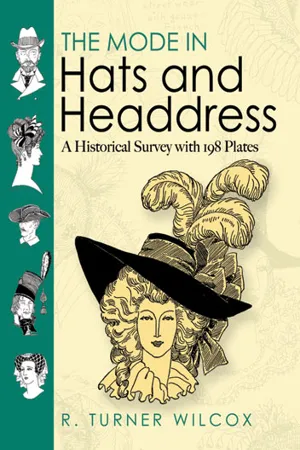
This is a test
- 368 pages
- English
- ePUB (mobile friendly)
- Available on iOS & Android
eBook - ePub
Book details
Book preview
Table of contents
Citations
About This Book
A year after R. Turner Wilcox received rave reviews for her ultimate fashion reference, The Mode in Costume, she decided to zero in on one chic category to give it the close-up it deserved. The result is this extraordinary handbook that covers the worldwide evolution of almost five thousand years of hats, hairstyles, and headdress for both sexes. Since ancient times, men and women have used hats and headgear for everything from adornment and protection to establishing their rank in society. With hundreds of illustrations and fascinating text, this comprehensive survey extends from 3000 B.C. to mid-twentieth century.
The showcase depicts an astonishing range of women's styles — Egyptian headdresses, Spanish mantillas, French straw sailor hats, buckle-trimmed tam-o-shanters, wedding veils, bonnets, snoods, and jeweled crowns. Men's headwear includes feather-trimmed turbans, soldiers' helmets, cowboy hats and top hats, derbies and boaters, berets, sombreros, and Homburgs. Hairstyles run the gamut as well: ringlets, topknots, and spit curls, ponytails, pageboys, and poodle cuts, as well as pompadours, mutton chops, and crew cuts. With delightful details on jewelry, cosmetics, and beauty treatments, this is a unique reference that fashion designers, stylists, and historians will treasure.
The showcase depicts an astonishing range of women's styles — Egyptian headdresses, Spanish mantillas, French straw sailor hats, buckle-trimmed tam-o-shanters, wedding veils, bonnets, snoods, and jeweled crowns. Men's headwear includes feather-trimmed turbans, soldiers' helmets, cowboy hats and top hats, derbies and boaters, berets, sombreros, and Homburgs. Hairstyles run the gamut as well: ringlets, topknots, and spit curls, ponytails, pageboys, and poodle cuts, as well as pompadours, mutton chops, and crew cuts. With delightful details on jewelry, cosmetics, and beauty treatments, this is a unique reference that fashion designers, stylists, and historians will treasure.
Frequently asked questions
At the moment all of our mobile-responsive ePub books are available to download via the app. Most of our PDFs are also available to download and we're working on making the final remaining ones downloadable now. Learn more here.
Both plans give you full access to the library and all of Perlego’s features. The only differences are the price and subscription period: With the annual plan you’ll save around 30% compared to 12 months on the monthly plan.
We are an online textbook subscription service, where you can get access to an entire online library for less than the price of a single book per month. With over 1 million books across 1000+ topics, we’ve got you covered! Learn more here.
Look out for the read-aloud symbol on your next book to see if you can listen to it. The read-aloud tool reads text aloud for you, highlighting the text as it is being read. You can pause it, speed it up and slow it down. Learn more here.
Yes, you can access The Mode in Hats and Headdress by R. Turner Wilcox in PDF and/or ePUB format, as well as other popular books in Design & Fashion Design. We have over one million books available in our catalogue for you to explore.
Information
Topic
DesignSubtopic
Fashion Design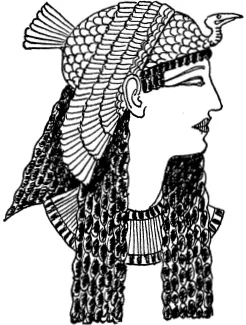
ANCIENT EGYPTIAN
CHAPTER ONE
THE EGYPTIANS in the protodynastic period wore their natural hair which was thick, wavy and dark brown. The ostrich plume was a masculine ornament for the head. Women dressed the hair into many tight braids and added ivory combs and hairpins.
Much attention and time was devoted to the care of the hair and elaborate hairdressing to which false hair was added. This led to the fashion of the wig in ancient Egypt. Both sexes, replacing natural hair with a ventilated wig, cut their hair very short or plucked or shaved their heads. Excessive heat and reasons of cleanliness as well as religion, had to do with the custom. Priests, the governor and the chief judge adopted the uncovered shaved head.
The Greek historian, Herodotus (484–425 B.C.) made the statement that the Egyptian whose head was shaved early in life, acquired a much harder skull than the Persian whose head was covered with a thick growth of hair. The hair was left to grow during a period of mourning.
Wigs were made of human hair, black sheep’s wool or palm leaf fibre dyed black and attached to a woven porous foundation which afforded ventilation and protection against the sun’s hot rays. Though black was the chosen color, it is known that there were blonds among the Egyptians. In the highly sophisticated period after about 1150 B.C., wigs worn by men and women were often of brilliant color, having been dyed red, green or blue. For pure creative and artistic decoration, the Egyptian headdress has never been surpassed. It is interesting to note the conventionalizing of ornamentation over the centuries, of the ribbon headband, flowers and feathers into stylized motifs of metal and jewels.
Wigs were worn by nobility, officers of rank and the wealthy, the lesser man wearing a skullcap of felt or no covering at all. The early Egyptians who were skilled in the dressing of animal skins, wore caps of leather.
The very short bob-like wig first worn by royalty, was later taken up by the commoner, but wigs of shoulder length or longer were confined to the upper class. Very often, the natural hair of the laborer was cut in a short bob. The klaft, Coptic for hood, was a national headdress worn by both sexes, an apron-shaped headcloth of linen worn tight round the forehead and falling loosely at the sides and back.
The crowns of the pharaohs were of several styles fashioned of metal, felt, straw, cotton, linen and wool, striped and embroidered. There was the tall pointed atef crown, another high flat-top shape wider at the top than at the head and the fillet of ribbon or metal with lappets hanging in back. A skullcap of fine linen was sometimes worn under the heavy crown. The high unadorned bonnet-like crown was worn by the early kings of Upper Egypt. About 3000 B.C. when the victorious King Narmer united the two kingdoms, he added the red wicker-work crown of Lower Egypt to that of Upper Egypt.
The Egyptian soldier of the New Kingdom wore a small round bronze helmet, from the center of which rose an apex or spike upon which was wound a ball of wool. Another decoration was a pair of buffalo horns, often woolen balls and the horns combined on the helmet. Contemporary with the Greco-Roman period, the same round helmet had metal horns. Although iron was known in antiquity, bronze appears to have been the oldest metal employed, dating back to about 3700 B.C. in Egypt.
In feminine headdress, the wig served the same purpose as the modern hat and a lady owned several in different styles and for different occasions. Some women retained their own hair to which they added false hair to simulate the size of the wig, the whole dressed in many tight braids, the fashion varying with the period. In the late period of foreign domination, the use of the wig over the cropped or shaven head gave way to long natural hair worn in Greco-Roman fashion.
Women wore interlaced flowers in their hair, the favorite blossom being the lotus, emblem of abundance. Works of art were the circlets of fine gold wire ornamented with small flowers of carnelian, lapis lazuli and turquoise glass. Both men and women wore the fillet or ribbon headband finished in back with the symbolic bowknot and short hanging ends, later simulated in metal, silver or gold and encrusted with semi-precious stones and glass.
Here is a description of such a crown or fillet of the Old Kingdom, 2680–2280 B.C. Of copper covered with gold leaf on a plaster coating, the circlet, a museum art treasure of today, is further enhanced with lotus flowers, birds and large rosettes formed of papyrus colored with paint and gilded gesso. Carnelian inlays also decorate the lovely piece.
Crowns and wigs changed with the dynasties and sometimes queens are portrayed with the tall bonnet-like crown and no wig. Both kings and queens can be seen wearing the crown over the striped fabric apron-shaped headdress. Especially handsome was the crown of vulture or hawk design, the head of the bird protruding from the forehead. It surmounted a wig and supposedly was worn only by an unmarried queen or princess.
The vulture signified the goddess of Upper Egypt and the cobra or sacred asp, the goddess of Lower Egypt, and, after the joining of the two kingdoms, both insignia were placed on the royal headdress. They were removable and fitted the different crowns that the ruler might wear to the various ceremonials. The sun disk sign of Uraeus, the sacred feather of truth, the cow’s horns, emblem of Hathor, goddess of love, all were ornaments of princely insignia.
Another sign of sovereignty was the postiche or false beard of metal, an adaptation of the genuine beard originally worn by the early kings. Sometimes gold threads were braided into the trim-kept, often dyed, beard. The plaited beard became the design of the later gold postiche, an ornament worn also by queens. It was held in place by a ribbon tied in back under wig or crown or attached to a gold chinstrap.
Both men and women made use of cosmetics. The eyes were accented with two colors, black and green, collyrite or kohl (the latter its Oriental name) and powdered green malachite. A black line was drawn round the eye with a small ivory or ebony stick dipped in kohl. The cheeks were colored with an ointment made of red clay mixed with a touch of saffron. Carmine was applied to the lips, the eyelashes were tipped with black pomade and the veins of the bosom accented with blue. That age-old artist’s pigment, white lead, was known both to the Egyptians and the Chinese and, though surely harmful to the skin, was used by their ladies to paint the face. Creams, oils and ointments were lavishly indulged in, men employing perfumed oils even for shaving.
In early times, the aromatics were only for religious ceremony and embalming but gradually Egyptians carried the use of them into their daily life. The precious perfumed oils were purchased from the priests who prepared them in the laboratories of the temples. Frankincense, saffron and myrrh were popular perfumes and still in use today. That the Egyptians were skilled in making perfumes was evident when after thirty-two hundred years, the tomb of Tutankhamen was opened and the perfumes used were still fragrant.
A strange custom indulged in when banqueting, was the wearing of an ornamental ritual cone of perfumed fat on top of the head or wig. When the party “waxed high” as we express it, the cone melted and ran down over the person.
Combs for dressing the hair were fashioned of metal, bone, ivory, boxwood and ebony. There were beautifully designed containers for the many cosmetics: small dishes, bottles and flagons of alabaster and finely polished stone and glass.
Small boys had their heads shaved, leaving a braided “lock of youth” on either side, while the long natural hair of little girls was plaited into several tight pigtails.
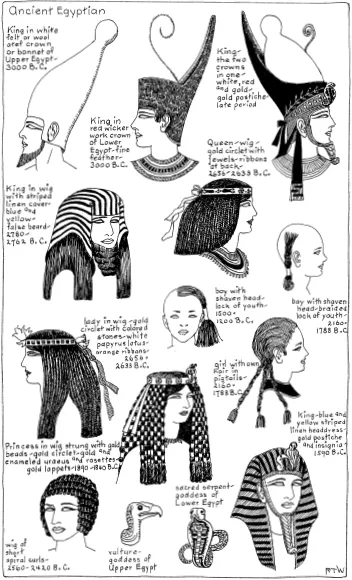
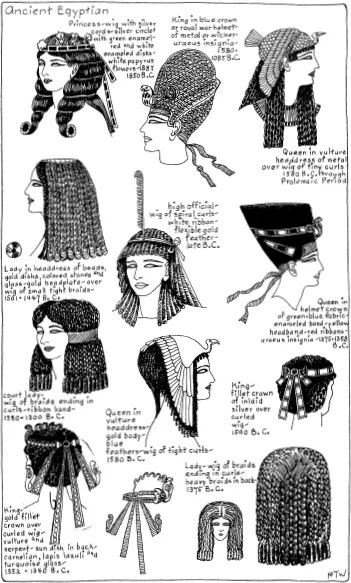
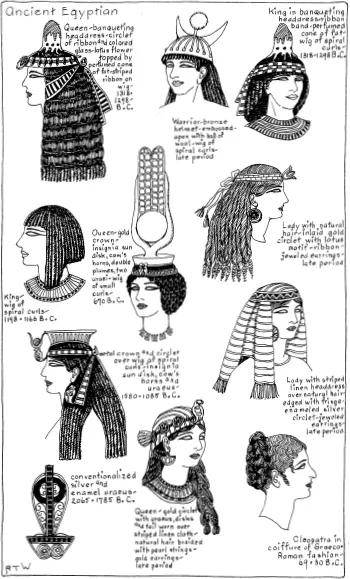

MESOPOTAMIAN
CHAPTER TWO
THIS TERM COMPRISES Chaldean, Babylonian, Assyrian, Median and ancient Persian civilization. Chaldean, Babylonian and Assyrian will be considered as one since they shared in common the distinctive characteristics of dress. The Babylonian Empire boasted a culture nearly as old as that of Egypt. It consisted in 1917 B.C. of Elam, Assyria and Syria. Babylonia was conquered 1250 B.C. by the Assyrians who in turn were subjugated by the Medes, to be in turn conquered by the Persians in 640 B.C.
Our information on the costume of these empires is to be had from coins and sculpture, principally low-relief decorations which ornamented the walls of their palaces and temples. Colors are furnished us by the well-preserved wall paintings of the Egyptian tombs.
Both men and women who were most fastidious and painstaking in the dressing of the elaborate coiffures, wore natural hair or wigs falling in length to the shoulders, waved, frizzed and in tight ringlets. In fact from ancient Phrygia in Asia Minor comes a word in our language, Phrygianize, which signifies “to frizzle or curl up.” Curling irons or tongs were used for the spiral curls. Upon festive occasions the hair was powdered with gold dust or scented with pulverized yellow starch. The masculine beard was given the same attention. Ointments were applied to the hair and it is known that the Assyrians resorted to a black dye for eyebrows, beard and hair. Persian men stained their hair and beards with henna dye of an orange-red color. To enhance the brilliancy of the eyes, the lids were edged with kohl. Heavy eyebrows were a sign of beauty especially if they met over the nose, and both men and women drew in the line with kohl. Women also used rouge.
The hats of ancient Mesopotamia were truly modern and with the exception of the beret and the sailor, we find all of today’s hat styles represented.
Tire, tiara and mitre or miter, all words of Greek origin in general signifying a crown, were the names given alike to the wide jeweled headband, the Asiatic turban and the tall conical hat which were worn by the Babylonians, Assyrians, Medes and Persians. Among the Persians the tall bonnet or crown was the tiara and the ornamented headband with ties or lappets hanging in back, the miter. Miter, which in our day is generally associated with ecclesiastic headgear, signified as late as the fifteenth century, a simple cap or calotte. Apropos the papal tiara of our time, that dates from the ninth century and the bishop’s miter from the twelfth century.
According to Xenophon the Greek historian (430–352 B.C.) the royal tiara of ancient Persia was a tall bonnet encircled with a diadem while the man of lesser rank wore a flexible one with lappets at the sides. Despite his statement, wall carvings extant portray kingly individuals attired in bonnets with lappets.
The king’s crown, tiara or miter, which varied in shape and height, was usually of white felt or wool around which was tied a band or fillet of linen or wool in blue, white or purple with two ends or lappets hanging at the sides or back. The crown was also enriched with embroidery, gold, pearls and precious stones. Embroidery, in fact, covered the entire costume with motifs based upon the rosette and was called “Babylonian work.” The lappets of the royal bonnet were long and had fringed ends while those of inferior rank were short and unadorned.
The crown or diadem, symbol of kingship in modern Europe and fast disappearing, owes its origin to the tied fillet of linen or woolen material of ancient Eastern Europe.
Other masculine headcoverings were the felt toque with or without turned-up band, the felt skullcap or helmet of the soldier and a draped turban of wool or linen with chincloth covering the shoulders. Persian soldiers wore a melon-shaped bonnet, also a hood resembling the Phrygian bonnet. The generally worn bonnet of Phrygia in Asia Minor, was a pointed hood of woolen cloth or felt. Women too are portrayed wearing it.
Women lived in harems and there is little graphic record of feminine dress, but that they also wore the bonnet is attested by one of the few portraits of the sex, a wall carving of the goddess Ishtar, also another, both wearing either the hat or the jeweled headband. A shee...
Table of contents
- Cover Page
- Title Page
- Chapter One
- Chapter Sixteen
- Chapter Seventeen
- Back Cover